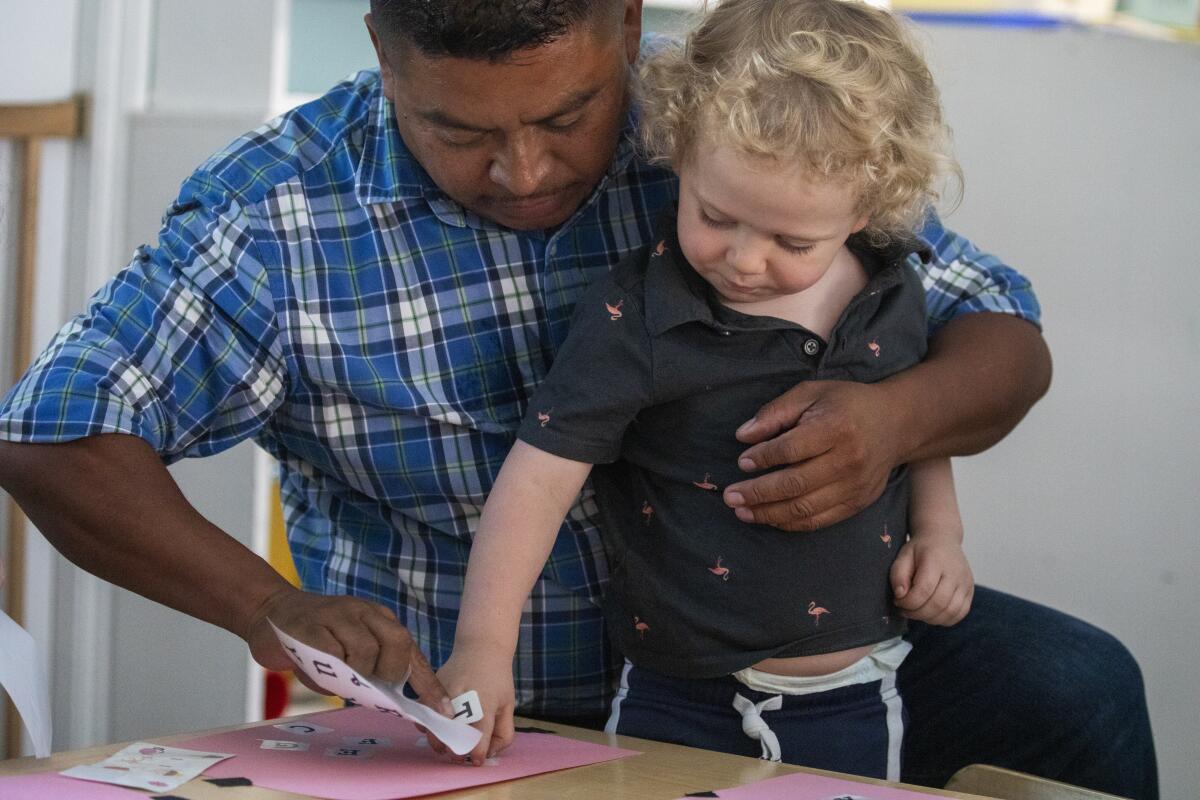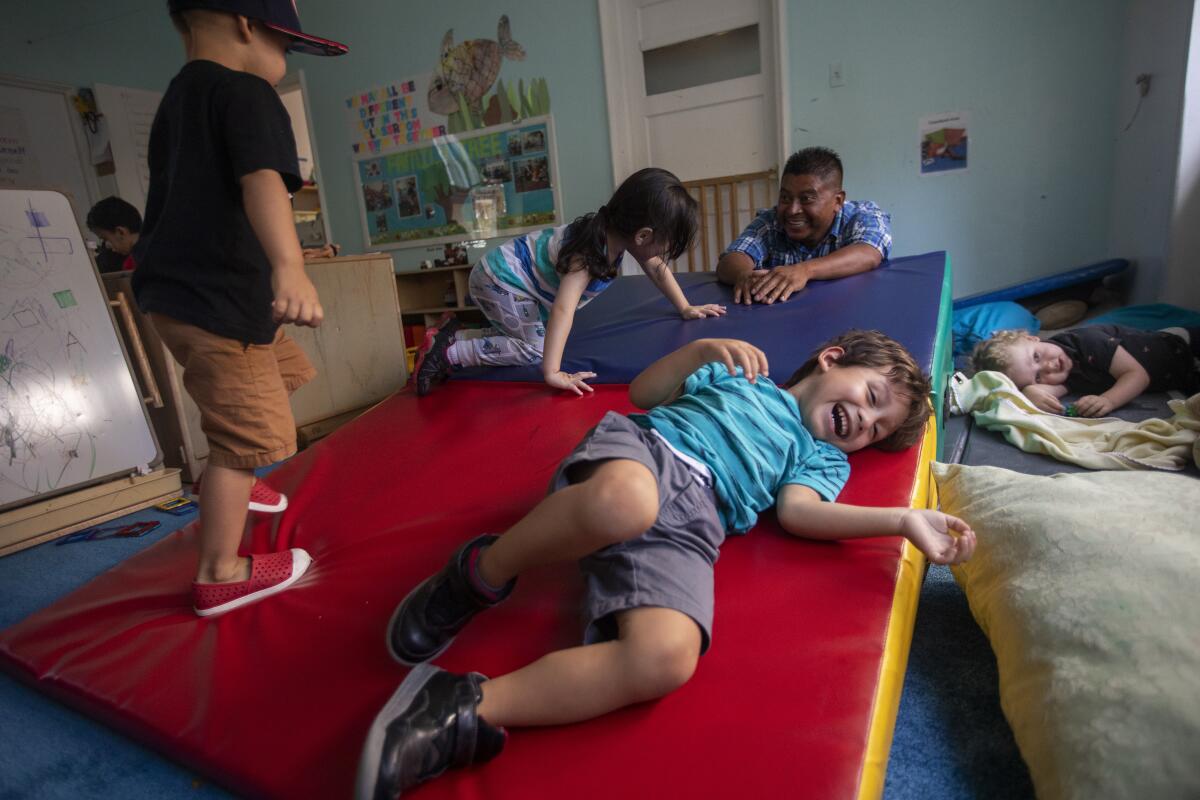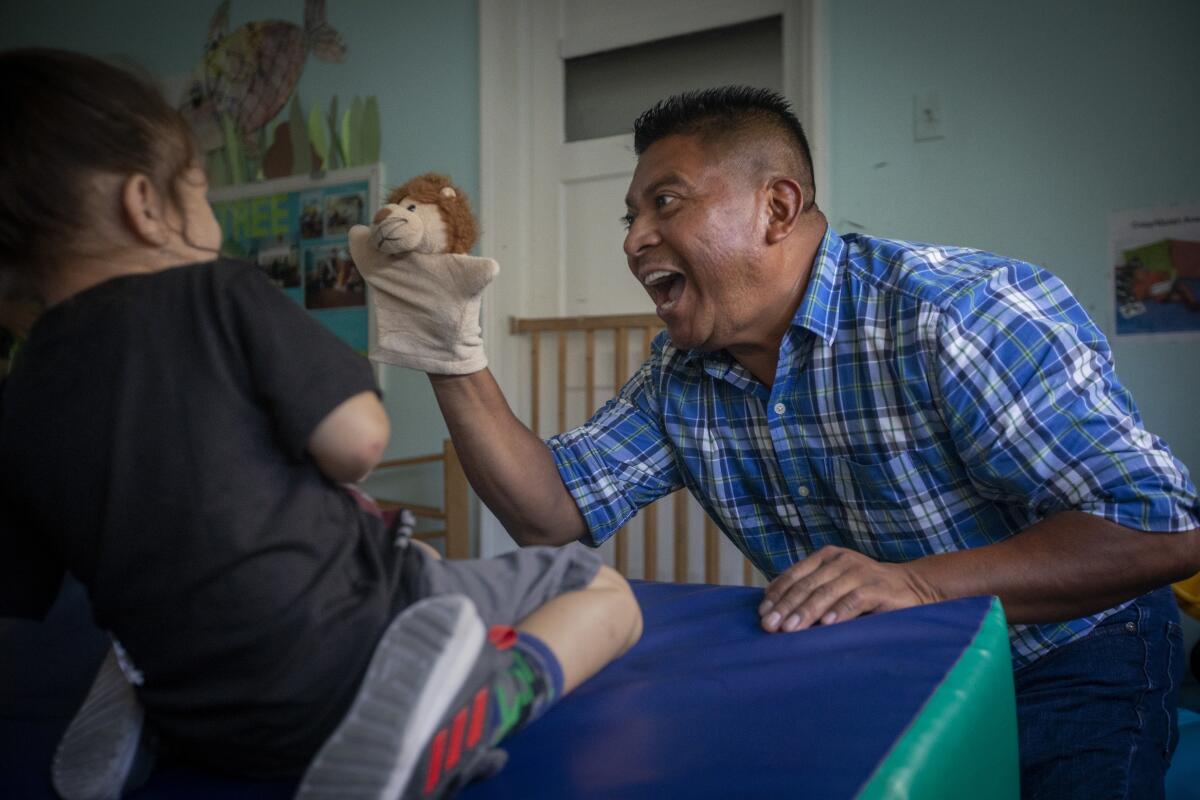Column: Gentrification opened a rift between an L.A. church and a children’s center. Can they both survive?

- Share via
On a quiet residential corner of Atwater Village, one long block south of Glendale Boulevard, two neighborhood institutions have cozily coexisted for decades. Atwater Park Baptist Church, which was was founded in 1923, also houses Atwater Park Center, an early childhood intervention program started by church members.
Since it opened in 1968, the center has helped thousands of small children with developmental disabilities get off to a good start. It has provided parents with the guidance and resources they need to try to maximize their children’s potential. It has done so completely independently from the church, which it reimburses monthly for its presence.
The current pastor, the Rev. James Schultz, is 84 and likes to whistle, and some of the center’s little ones call him Grandpa. Over the years, the relationship between church and center has been warm.
But recently the leadership of the two institutions found themselves in a strained standoff over money — fueled in part by neighborhood change.
Both fear for their futures. Both face growing pressures. Both knew the high stakes involved. In this rapidly gentrifying neighborhood, even when their desires don’t intersect, they may have little choice but to stick together if they want to survive and stay firmly planted among those they serve.
The nonprofit center, for ages 2 to 5, depends on the referrals it gets from two regional centers that connect children eligible for free government services with the programs that provide them. It came close to closing its doors during the Great Recession, when the state simultaneously slashed funding and tightened eligibility and its enrollment plummeted. Teachers temporarily took cuts in hours and pay.
Parting ways with the church now, at a time of rising rents, could mean that the center would have to leave the neighborhood — maybe permanently.

The church, meanwhile, has long kept the center’s costs low and even accepted an extended rent reduction for more than four years after the recession. But it has a shrinking congregation and budget and depends on the money it gets from the center — which, given zoning and licensing rules, it might not find so easy to replace.
This spring its moderator, Rodrigo Dilig, informed the center in a letter that it would need to increase its monthly payment by nearly 33 percent, from $5,500 to $7,291, to cover rising utility costs as well as janitorial services and supplies. That’s still well below comparable area rates, he was quick to point out.
The center’s leadership saw this letter, which called for annual increases, as the harbinger of a frightening, increasingly unaffordable future. While it receives donations and some private tuition, the bulk of the center’s budget comes from the referrals’ state and federal funding, over which it has no control.
Carla Poole, the center’s executive director, who is an early childhood development specialist, first came to the center as a board member during the recession. Then in 2013, at a time when she might have retired, she offered to run the program salary-free for a year to try to ensure its survival. That’s been an ongoing process.
My son was over 2 years old and didn’t have any language, and within three months he was talking and engaging.
— James Lewis, parent of twins
“The situation could become unsustainable for us,” Poole said of annual increases.
Gentrification has its victims. We’re all too familiar with some of them. Rents start to soar. Little bungalows get flipped to woo wealthier newcomers. Longtime residents and mom-and-pop businesses soon find themselves priced out.
When I first heard about the fight between the church and the center, I started to think about less visible ripple effects — about the stress for nonprofits that are like senior citizens living on fixed incomes, with a certain amount of money coming in each month and not much chance for more. I thought about institutions built for different times that find themselves forgotten. The century-old church seemed to me one of those.
On Wednesday, Dilig made it clear to me that the church has its own existential worries. It needs to justify its continued existence, but struggles to keep up with basic maintenance, let alone any missionary goals, he said — though he declined to say what those goals were.
“They get funding. We don’t get funding. Who gets the short end of the stick? It’s always us,” Dilig said.

Once upon a time, the church had a large enough congregation not to have to fret about how much money it got back from the center. Its first members were white and middle class. Its membership grew steadily. It had the means to do community service projects and hold drive-in services at Forest Lawn with the sermons broadcast on the radio.
These days, the congregation is down to 25 or 30 mostly Filipino members, in a neighborhood whose demographics are changing and whose newer, younger families may not gravitate toward old-fashioned churchgoing.
“Maybe we’re going into the churchless society. I don’t know,” Dilig said.
The center, after the recession funding cuts, worked hard to harness gentrification to its benefit. Staff reached out to new families moving into Atwater Village — and began to bring in new revenue by enrolling tuition-paying neighborhood children, most of whom did not have developmental issues. Those children now make up about a third of the center’s roster. Having to move elsewhere could sever those new connections.
The resulting classroom mix also has created some beautiful bonds, as children naturally accommodate and help each other out, unfazed by their differences.
It was part of what most appealed to Randy Roberts and James Lewis of Toluca Lake, who enrolled their 2-year-old twins at the center. The couple paid tuition for Anna, who had been slow to crawl. Through the Frank D. Lanterman Regional Center, William had been diagnosed with autism and so his way is paid. He especially responded to a type of therapy called Floortime in which teachers — including Poole — got down on the floor with him and interacted at eye level.
“My son was over 2 years old and didn’t have any language, and within three months he was talking and engaging,” Lewis said. “If I hadn’t found the center, we wouldn’t be where we are today.”
The center also has been crucial for many parents who come grieving their unexpected circumstances. Some arrive ashamed to tell family and friends of their children’s issues. Some come with no expectation that their children can do much of anything for themselves.
It’s exciting to watch as toddlers with special needs who might have been under-challenged at home settle into the center’s playful, stimulating and very well-thought-out world and sometimes slowly become more social and adventurous.
“You see them just taking leaps and bounds when they get into a structured, organized, consistent, predictable routine that’s really driven by a curriculum,” said Kate Crowley, the center’s consulting occupational therapist and an assistant professor at USC.
Many of the children referred to the center have been diagnosed — or are considered at risk of being diagnosed — with autism. Often, they have severe speech delays or social difficulties.
Santos Mundo, 48, started in a summer jobs program for low-income youth when he was a teenager. He’s one of several teachers who have been there for decades.
With all their experience, they have become fine “sensory detectives,” Crowley said, sussing out what the children find difficult or frightening and looking for ways to help change their responses.
On a recent morning, I sat in Ricky Gonzalez’s classroom, where all the children were on the autism spectrum.
Some played together. One stretched out alone on the carpet. One sat at a table intently focused on a set of magnetized wooden blocks, which he kept putting together and then pulling apart, over and over again.
I listened as Gonzalez, who is a father of five, moved through the room, narrating to the children and thus grounding them in the experiences he was sharing with them. I saw how he went to fetch a puzzle, which he knew the lone child on the carpet loved, and then waited for the child to notice and to start edging toward him.
I watched when a girl started to shriek and this teacher of 19 years drew a circle on the table, redirecting her focus.
To me, he was a magician, with the right spell for every occasion. The more I tracked how he looked from child to child, the more I watched how he moved, the more the skill I was witnessing felt rare.
So I wasn’t surprised to learn Thursday that the center had met the church’s full demand and signed a two-year agreement.
Some things you can take or leave.
Some are just too important to risk losing in a fight.
More to Read
Sign up for Essential California
The most important California stories and recommendations in your inbox every morning.
You may occasionally receive promotional content from the Los Angeles Times.











